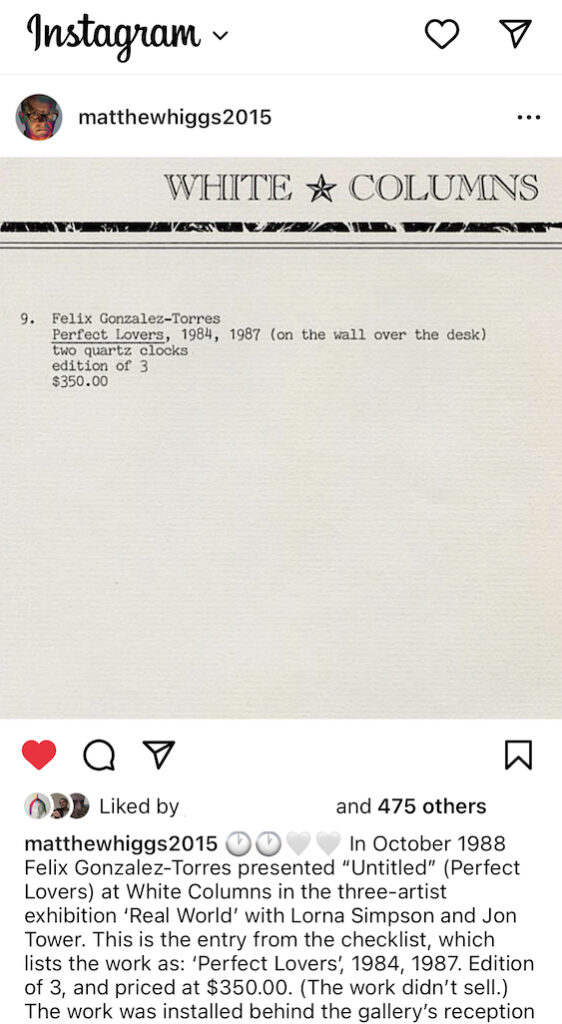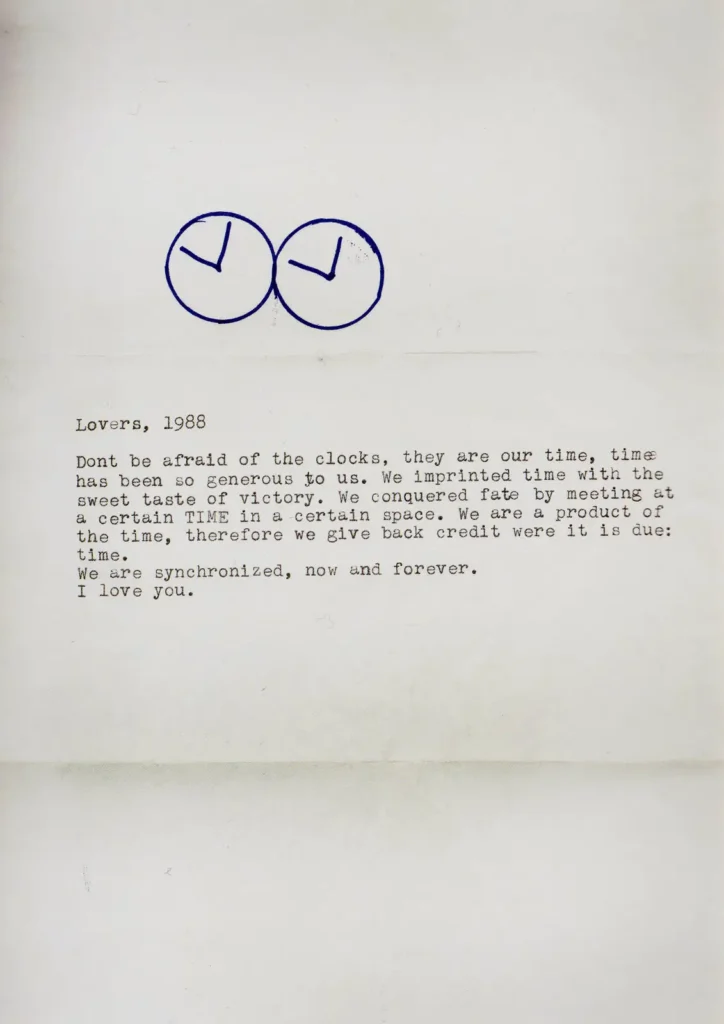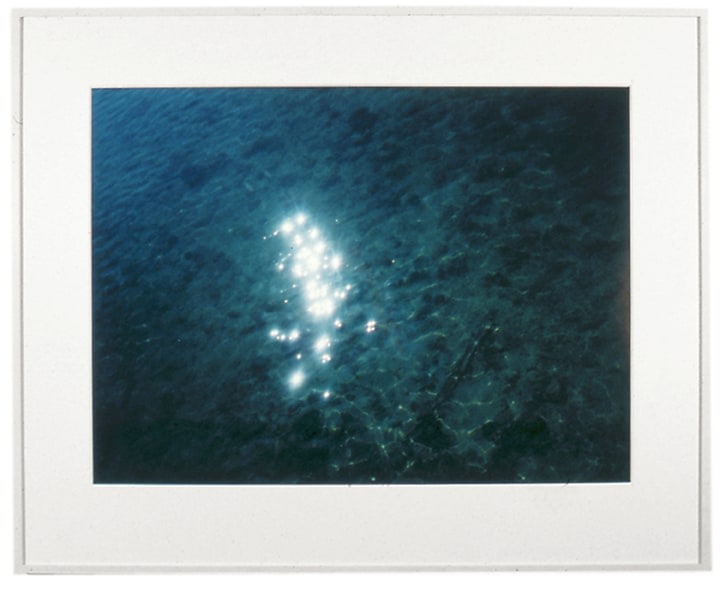
“It’s like living art history while trying to study it,” I wrote in 2021. Today I’d say clocks keep ticking, in sync or gradually not, but understanding comes in quick bursts, sometimes in the comments on Instagram.
White Columns director Matthew Higgs’ Valentine’s Day post was of the original 1988 checklist entry for Félix Gonzalez-Torres’ work, “Perfect Lovers,” which consisted of two 9.75-inch diameter quartz clocks installed next to each other over the desk:
🕙 🕙🤍🤍 In October 1988 Félix Gonzalez-Torres presented “Untitled” (Perfect Lovers) at White Columns in the three-artist exhibition ‘Real World’ with Lorna Simpson and Jon Tower. This is the entry from the checklist, which lists the work as “Perfect Lovers”, 1984, 1987. Edition of 3, and priced at $350.00 (The work didn’t sell.) The work was installed behind the gallery’s reception desk. This was, I believe, the first public presentation of the work, and the checklist is the only time I have seen it dated this way, ie. “1984/ 1987.” (The Wikipedia entry for the work lists its dates as 1987-1990, and suggests it was first shown at Jay Gorney’s gallery in 1990.) 🕙 🕙🤍🤍 #perfectlovers @felixgonzaleztorres.foundation @white_columns @davidzwirner @andrearosengal @jaygorney1 #valentinesday
I responded that the catalogue raisonné did list White Columns’ 1988 show as the first exhibition of “Untitled” Perfect Lovers [cat. 108], with a date of 1987-1990. But that an in-process page of the Foundation’s website says that work was a separate work—now not classified as work—titled “Perfect Lovers,” with the dates 1984/1987. [The CR lists “Perfect Lovers” as A25, with a date of 1987.]
This all syncs with what seemed to be going on in 2009, when Higgs included the clocks and the checklist in his White Columns 40th anniversary show. And in 2010 when, in the wake of Tobias Wong’s death, I tried to find all of Félix’s clocks, and some of the others they inspired. Except the 1984 date is a mystery.
Then who weighs in on Higgs’ post but Bill Arning, who was the director of White Columns at the time, who curated the show—and who typed the checklist:
The work was not planned to be in the show at all during our studio visits but right before we were done installing Félix walked in with a bag, and he had bought the two clocks on his way that morning. They were not fancy clocks at all, little plastic things, and FGT asked if he could hang them over my desk and he did, and then explained the concept of the piece to me so I added them to the checklist. it is always shocking how casual grand moments in art history actually are when you[‘re] living through them.
“Any recollection of how the date 1984 came about? Was this an idea he’d had at the time or for a while?” I asked.
“I know he specified it but I don’t remember the argument—working with him require a belief that he knew what he was doing,” Bill replied.
Indeed it does. Indeed it does. So while we don’t know why the date 1984 is attached, we know Félix knew. Which is something. Knowing that he lived and loved with an awareness of time, of sharing it, of conquering it, of marking it.

The CR listed “Perfect Lovers,” as “signed, titled, dated, and numbered 1/3” on the back of each clock, and in the collection of Jorge Collazo. Perhaps this is the source of the 1984 date. These don’t sound like the same clocks Félix pulled out of a bag on the way to White Columns, and which are still there somewhere, at least through 2009. So now we can assume there is another (pair).

Collazo is mentioned several times in Félix’s oeuvre, as the owner of images used in billboards, and presumably as the Jorge in letters turned into puzzles and photographs. And the the artist’s published bio, “1991 Jorge stopped talking to me, I’m lost—Claudio and Miami Beach saved me.” and on the back of a puzzle given to another friend, “Sunlight over the water in between Key West & Miami – trip with Jorge,” which the artist also used for a photo work, “Untitled” (Jorge), 1992. Who another friend Jim Hodges described, in his 2009 artist statement at the FLAG Foundation, as “a missing friend who was often mentioned.”
Maybe an answer is there. With Jorge, or on the backs of his clocks. It all really makes me want to sit people down and ask them questions, and record their memories, and their experiences, while there’s still time.
Previously, related: 2010, Perfect Lovers (Forever) by Tobias Wong
2021, “It’s like living art history while trying to study it.” where I wind myself too tight and then chill tf out on the subject of catalogue raisonné appendices
